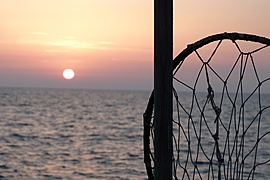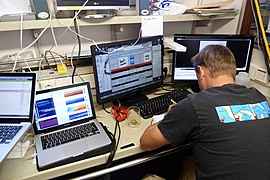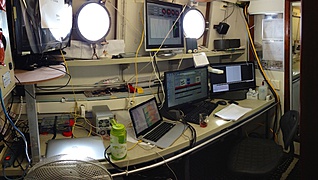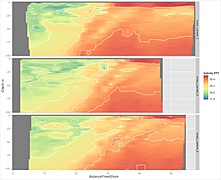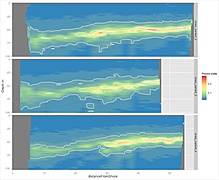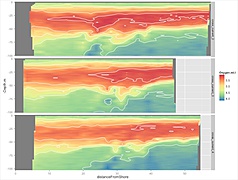A few transects later
by Jean-Olivier Irisson, on
We have now been successfully sampling the Ligurian current for the past three days!
Of course there were still a few bumps in the road. Despite our efforts to dry the inside of the camera pod of ISIIS, which took in a little sea water on Sunday, condensation was still forming on the lens when ISIIS was in warm surface waters, obscuring the images. But with a more intense cleanup of the pod and optical system, and with the help of the crew's hairdryer (!) we managed to dry it completely and it has worked beautifully since.
We could not communicate with UVP and ISIIS simultaneously, so we had to devise a startup sequence that would allow us to set UVP up before we started communicating with ISIIS. This eventually worked and we could deploy the ISIIS+UVP (now happy) couple for a few days. However, we then realised it was a much more intense deployment schedule than what is usual for these instruments. We deployed them for over 14h straight, with pauses of only a couple hours between deployments, when ISIIS had been used for a maximum of 8h and UVP profiles are usually not longer than 5 h. This was taking a toll on the gear and we were loosing bolts and nuts here and there. We decided to take out the UVP from inside ISIIS to avoid damaging the instruments.
We still have a few 20 miles transects with both instruments taking images, all sensors working and complemented by the ship's data collection at the surface. By interpolating and plotting the hydrological data collected by ISIIS in real-time, we were able to tell when we crossed the front and to pay attention to the differences in the biology between sides of the front, since ISIIS images are displayed live while sampling. Here are a few rough interpolations of the salinity, fluorometry, and oxygen across the frontal structure. We had a well defined front with a thin surface layer. The biological communities looked very different on both sides of the front from our sneak peak to ISIIS data. Now we need to proceed with the analysis!

